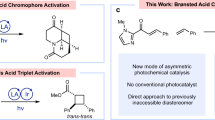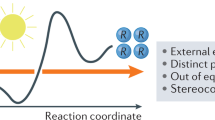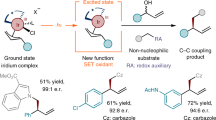Abstract
Asymmetric catalytic variants of sunlight-driven photochemical processes hold extraordinary potential for the sustainable preparation of chiral molecules. However, the involvement of short-lived electronically excited states inherent to any photochemical reaction makes it challenging for a chiral catalyst to dictate the stereochemistry of the products. Here, we report that readily available chiral organic catalysts, with well-known utility in thermal asymmetric processes, can also confer a high level of stereocontrol in synthetically relevant intermolecular carbon–carbon bond-forming reactions driven by visible light. A unique mechanism of catalysis is proposed, wherein the catalyst is involved actively in both the photochemical activation of the substrates (by inducing the transient formation of chiral electron donor–acceptor complexes) and the stereoselectivity-defining event. We use this approach to enable transformations that are extremely difficult under thermal conditions, such as the asymmetric α-alkylation of aldehydes with alkyl halides, the formation of all-carbon quaternary stereocentres and the control of remote stereochemistry.
This is a preview of subscription content, access via your institution
Access options
Subscribe to this journal
Receive 12 print issues and online access
$259.00 per year
only $21.58 per issue
Buy this article
- Purchase on Springer Link
- Instant access to full article PDF
Prices may be subject to local taxes which are calculated during checkout





Similar content being viewed by others
References
Balzani, V., Credi, A. & Venturi, M. Photochemical conversion of solar energy. ChemSusChem, 1, 26–58 (2008).
Ciamician, G. The photochemistry of the future. Science 36, 385–394 (1912).
Albini, A. & Fagnoni, M. Handbook of Synthetic Photochemistry (Wiley-VCH, 2010).
Bach, T. & Hehn, J. P. Photochemical reactions as key steps in natural product synthesis. Angew. Chem. Int. Ed. 50, 1000–1045 (2011).
Inoue, Y. & Ramamurthy, V. Chiral Photochemistry (Marcel Dekker, 2004).
Müller, C. & Bach, T. Chirality control in photochemical reactions: enantioselective formation of complex photoproducts in solution. Aust. J. Chem. 61, 557–564 (2008).
Ojima, I. Catalytic Asymmetric Synthesis (Wiley, 2010).
Guo, H., Herdtweck, E. & Bach, T. Enantioselective Lewis acid catalysis in intramolecular [2+2] photocycloaddition reactions of coumarins. Angew. Chem. Int. Ed. 49, 7782–7785 (2010).
Bauer, A., Westkamper, F., Grimme, S. & Bach, T. Catalytic enantioselective reactions driven by photoinduced electron transfer. Nature 436, 1139–1140 (2005).
Müller, C., Bauer, A. & Bach, T. Light-driven enantioselective organocatalysis. Angew. Chem. Int. Ed. 48, 6640–6642 (2009).
Knowles, R. R. & Jacobsen, E. N. Attractive noncovalent interactions in asymmetric catalysis: links between enzymes and small molecules catalysts. Proc. Natl Acad. Sci. U.S.A. 107, 20678–20685 (2010).
Nicewicz, D. A. & MacMillan, D. W. C. Merging photoredox catalysis with organocatalysis: the direct asymmetric alkylation of aldehydes. Science 322, 77–80 (2008).
Shih, H-W., Vander Wal, M. N., Grange, R. L. & MacMillan, D. W. C. Enantioselective α-benzylation of aldehydes via photoredox organocatalysis. J. Am. Chem. Soc. 132, 13600–13603 (2010).
Mulliken, R. S. Molecular compounds and their spectra. II. J. Am. Chem. Soc. 74, 811–824 (1952).
Foster, R. Electron donor–acceptor complexes. J. Phys. Chem. 84, 2135–2141 (1980).
MacMillan, D. W. C. The advent and development of organocatalysis. Nature 455, 304–308 (2008).
Mukherjee, S., Yang, J. W., Hoffmann, S. & List, B. Asymmetric enamine catalysis. Chem. Rev. 107, 5471–5569 (2007).
Cantacuzene, D., Wakselman, C. & Dorme, R. Condensation of perfluoroalkyl iodides with unsaturated nitrogen compounds. J. Chem. Soc. Perkin Trans. 1 1365–1371 (1977).
Russell, G. A. & Wang, K. Electron transfer processes. 53. Homolytic alkylation of enamines by electrophilic radicals. J. Org. Chem. 56, 3475–3479 (1991).
Singh, J. O., Anunziata, J. D. & Silber, J. J. n–π Electron donor–acceptor complexes. II. Aliphatic amines with dinitrobenzenes. Can. J. Chem. 63, 903–907 (1985).
Müller, K., Previdoli, F. & Desilvestro, H. Enamines, II. A theoretical and photoelectron spectroscopic study of the molecular and electronic structures of aliphatic enamines. Helv. Chim. Acta 64, 2497–2507 (1981).
Rosokha, S. V. & Kochi, J. K. Fresh look at electron-transfer mechanisms via the donor/acceptor bindings in the critical encounter complex. Acc. Chem. Res. 41, 641–653 (2008).
Hilinski, E. F., Masnovi, J. M., Amatore, C., Kochi, J. K. & Rentzepis, P. M. Charge-transfer excitation of electron donor–acceptor complexes. Direct observation of ion pairs by time-resolved (picosecond) spectroscopy. J. Am. Chem. Soc. 105, 6167–6168 (1983).
Rathore, R. & Kochi, J. K. Donor/acceptor organizations and the electron-transfer paradigm for organic reactivity. Adv. Phys. Org. Chem. 35, 193–318 (2000).
Gotoh, T., Padias, A. B. & Hall, J. H. K. An electron donor–acceptor complex and thermal triplex as intermediates in the cycloaddition reaction of N-vinylcarbazole with dimethyl 2,2-dicyanoethylene-1,1-dicarboxylate. J. Am. Chem. Soc. 113, 1308–1312 (1991).
Berionni, G., Bertelle, P-A., Marrot, J. & Goumont, R. X-ray structure of a CT complex relevant to Diels–Alder reactivity of anthracenes. J. Am. Chem. Soc. 131, 18224–18225 (2009).
Melchiorre, P. Light in aminocatalysis: the asymmetric intermolecular α-alkylation of aldehydes. Angew. Chem. Int. Ed. 48, 1360–1363 (2009).
Jensen, K. L., Dickmeiss, G., Jiang, H., Albrecht, Ł. & Jørgensen, K. A. The diarylprolinol silyl ether system: a general organocatalyst. Acc. Chem. Res. 45, 248–264 (2012).
Costentin, C., Robert, M. & Savéant, J-M. Electron transfer and bond breaking: recent advances. Chem. Phys. 324, 40–56 (2006).
Mannschreck, A., Roza, P., Brockmann, H. & Kemmer, T. Demonstration of diastereomeric electron-donor–acceptor complexes by 1H-NMR spectroscopy. Angew. Chem. Int. Ed. Engl. 17, 940–942 (1978).
Kornblum, N. Substitution reactions which proceed via radical anion intermediate. Angew. Chem. Int. Ed. Engl. 14, 734–745 (1975).
Russell, G. A., & Ros, F. Reactions of α-halo ketones with nucleophiles J. Am. Chem. Soc. 107, 2506–2511 (1985).
Rossi, R. A., Pierini, A. B. & Peñéñory, A. B. Nucleophilic substitution reactions by electron transfer. Chem. Rev. 103, 71–168 (2003).
Van Humbeck, J. F., Simonovich, S. P., Knowles, R. R. & MacMillan, D. W. C. Concerning the mechanism of the FeCl3-catalyzed α-oxyamination of aldehydes: evidence for a non-SOMO activation pathway. J. Am. Chem. Soc. 132, 10012–10014 (2010).
Nazareno, M. A. & Rossi, R. A. SRN1 reactions of 7-iodobicyclo[4.1.0]heptane, 1-iodoadamantane, and neopentyl iodide with carbanions induced by FeBr2 in DMSO. J. Org. Chem. 61, 1645–1649 (1996).
Narayanam, J. M. R. & Stephenson, C. R. J. Visible light photoredox catalysis: applications in organic synthesis. Chem. Soc. Rev. 40, 102–113 (2011).
Acknowledgements
This work was supported by the Institute of Chemical Research of Catalonia Foundation and by the European Research Council under the European Community's Seventh Framework Program (FP7 2007–2013)/ERC Grant agreement 278541. This work is dedicated to P. G. Cozzi on the occasion of his 50th birthday.
Author information
Authors and Affiliations
Contributions
E.A. and I.D.J. were involved in the discovery and subsequent development of the light-driven alkylation reactions. E.A., I.D.J. and A.Á-F. performed the experiments. E.A., I.D.J., A.Á-F. and P.M. designed and analysed the experiments. P.M. conceived and directed the project and wrote the manuscript with contributions from E.A.
Corresponding author
Ethics declarations
Competing interests
The authors declare no competing financial interests.
Supplementary information
Supplementary information
Supplementary information (PDF 6665 kb)
Supplementary information
Crystallographic data for compound 1c (CIF 27 kb)
Rights and permissions
About this article
Cite this article
Arceo, E., Jurberg, I., Álvarez-Fernández, A. et al. Photochemical activity of a key donor–acceptor complex can drive stereoselective catalytic α-alkylation of aldehydes. Nature Chem 5, 750–756 (2013). https://doi.org/10.1038/nchem.1727
Received:
Accepted:
Published:
Issue Date:
DOI: https://doi.org/10.1038/nchem.1727
This article is cited by
-
New strategies for asymmetric photocatalysis: asymmetric organocatalytic/photoredox relay catalysis for efficient synthesis of polycyclic compounds containing vicinal amino alcohols
Science China Chemistry (2024)
-
Biomimetic asymmetric catalysis
Science China Chemistry (2023)
-
Construction of axial chirality via asymmetric radical trapping by cobalt under visible light
Nature Catalysis (2022)
-
Reactant-induced photoactivation of in situ generated organogold intermediates leading to alkynylated indoles via Csp2-Csp cross-coupling
Nature Communications (2022)
-
Light-empowered contra-thermodynamic stereochemical editing
Nature Reviews Chemistry (2022)



